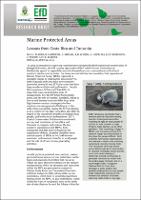Marine Protected Areas: Lessons from Costa Rica and Tanzania
Fecha de publicación
22-07-2015Autor
Heidi J., Albers
Róger, Madrigal
Stephen, Kirama
Razack, Lokina
Aloyce, Hepelwa
Elizabeth J Z, Robinson
Jane, Turpie
Alpízar, Francisco
Tipo
Reporte técnico
Metadatos
Mostrar el registro completo del ítemResumen
Both Tanzania’s and Costa Rica’s beaches provide important nesting sites for endangered sea turtles. Poaching of eggs by local people for food or for sale presents a major threat to these species, as do other predators. This harvesting of eggs in MPAs, and throughout Costa Rica, remains illegal, but enforcement on long beaches proves difficult. Both countries have active organizations that attempt to reduce this poaching, sometimes involving moving nests. The Tanzanian NGO Sea Sense works directly with local communities to increase knowledge and to provide cash from tourist viewing of hatchlings to local communities to generate incentives to refrain from harvesting eggs. Similarly, but on a much larger scale, Tortuguero National Park in Costa Rica manages a guide system that provides employment to local people while maintaining controls on the number and behavior of tourists watching turtles hatch or lay eggs.
Palabras clave
Editor
CATIE, Turrialba (Costa Rica)
URI (Enlace permanente para citar o compartir este ítem)
https://repositorio.catie.ac.cr/handle/11554/9561Colecciones
- Publicaciones y documentos [4188]



